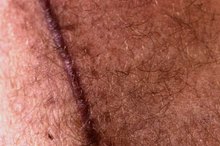What does fact checked mean?
At Healthfully, we strive to deliver objective content that is accurate and up-to-date. Our team periodically reviews articles in order to ensure content quality. The sources cited below consist of evidence from peer-reviewed journals, prominent medical organizations, academic associations, and government data.
- Linus Pauling Institute Research Report: All About E: Does Topical Vitamin E Improve Skin Appearance?
- Plastic and Reconstructive Surgery: Effect of Mederma on Hypertrophic Scarring in the Rabbit Ear Model
- Plastic and Reconstructive Surgery: Effect of Mederma on Hypertrophic Scarring in the Rabbit Ear Model
The information contained on this site is for informational purposes only, and should not be used as a substitute for the advice of a professional health care provider. Please check with the appropriate physician regarding health questions and concerns. Although we strive to deliver accurate and up-to-date information, no guarantee to that effect is made.
Mederma Vs. Vitamin E Oil
If your skin is marked as the result of acne or an injury, or if you are healing from a surgical incision, you may wish to use a product to help minimize scarring. Vitamin E has long been touted as a useful treatment for scars. You can also purchase a commercial product, Mederma, which claims to diminish scars 2. When using either treatment, watch for evidence of itching or swelling. If you experience any symptoms, discontinue use of the product and consult your physician.
Vitamin E
Vitamin E is the term used to describe a group of tocol and tocotrienol derivatives, one of which -- alpha-tocopherol -- is a useful part of the human diet. Vitamin E is an ingredient in most skin creams, and when applied topically, a small amount penetrates the skin surface where it has beneficial antioxidant effects, according to the Linus Pauling Institute at Oregon State University. You can purchase vitamin E in liquid or capsule form. If using the pill form, puncture the capsule with a pin and squeeze out the liquid.
- Vitamin E is the term used to describe a group of tocol and tocotrienol derivatives, one of which -- alpha-tocopherol -- is a useful part of the human diet.
- Vitamin E is an ingredient in most skin creams, and when applied topically, a small amount penetrates the skin surface where it has beneficial antioxidant effects, according to the Linus Pauling Institute at Oregon State University.
Mederma
How to Use Vaseline to Care for a Scar
Learn More
Merz Pharmaceuticals, makers of Mederma products, claim that using Mederma helps make scars less noticeable and promotes softer and smoother skin tissue in the area of the scar 2. Mederma Skin Care for Scars is a greaseless, invisible topical gel 2. The primary active ingredient in the product’s patented formula is a proprietary botanical extract called Cepalin. You can apply Mederma to a wound as soon as it is healed, or in the case of surgical scars, when the sutures are removed 2. You use the gel three to four times per day for eight weeks on a new scar, or for three to six months on an existing scar 2.
Vitamin E Effects
Evidence from scientific studies suggests against the use of vitamin E as a scar preventive. The effectiveness of topical vitamin E in treating surgical wounds is not proven, and in some individuals it can cause contact dermatitis. A 1999 study performed at the University of Miami Department of Dermatology and Cutaneous Surgery showed that applying topical vitamin E not only did not help the appearance of scar tissue, but in some cases actually worsened the cosmetic appearance of scars 3.
- Evidence from scientific studies suggests against the use of vitamin E as a scar preventive.
- A 1999 study performed at the University of Miami Department of Dermatology and Cutaneous Surgery showed that applying topical vitamin E not only did not help the appearance of scar tissue, but in some cases actually worsened the cosmetic appearance of scars 3.
Mederma Effects
Vitamin C for Cystic Acne
Learn More
A 2002 study performed on rabbit ears at Northwestern University Medical School in Chicago showed a significant improvement in dermal collagen organization following the use of Mederma 2. The "Journal of Cosmetic Dermatology" reported on a 2009 study that found among subjects who had lesions removed from their upper chests, more than three-quarters of those using Mederma reported a moderate to significant improvement is the appearance of their scars 25.
Related Articles
References
- Linus Pauling Institute Research Report: All About E: Does Topical Vitamin E Improve Skin Appearance?
- Mederma: Mederma Scar Gel
- Dermatology.org: Topical Vitamin E Formulations: Not Always Benign
- Plastic and Reconstructive Surgery: Effect of Mederma on Hypertrophic Scarring in the Rabbit Ear Model
- Journal of Cosmetic Dermatology: Study Shows Mederma's Effectiveness
- Draelos ZD, Baumann L, Fleischer AB Jr, Plaum S, Avakian EV, Hardas B. A new proprietary onion extract gel improves the appearance of new scars: a randomized, controlled, blinded-investigator study. J Clin Aesthet Dermatol. 2012;5(6):18-24.
- Karppinen SM, Heljasvaara R, Gullberg D, Tasanen K, Pihlajaniemi T. Toward understanding scarless skin wound healing and pathological scarring. F1000Res. 2019;8. doi:10.12688/f1000research.18293.1
- Junker JPE, Kamel RA, Caterson EJ, Eriksson E. Clinical Impact Upon Wound Healing and Inflammation in Moist, Wet, and Dry Environments. Adv Wound Care. 2013;2(7):348-356. doi:10.1089/wound.2012.0412
- Owji N, Khademi B, Khalili MR. Effectiveness of topical onion extract gel in the cosmetic appearance of blepharoplasty scar. J Clin Aesthet Dermatol. 2018;11(10):31–35.
- Chung VQ, Kelley L, Marra D, Jiang SB. Onion extract gel versus petrolatum emollient on new surgical scars: prospective double-blinded study. Dermatol Surg. 2006;32(2):193-197. doi:10.1111/j.1524-4725.2006.32045.x
Writer Bio
Gwen Bruno has been a full-time freelance writer since 2009, with her gardening-related articles appearing on DavesGarden. She is a former teacher and librarian, and she holds a bachelor's degree in education from Augustana College and master's degrees in education and library science from North Park University and the University of Wisconsin.








